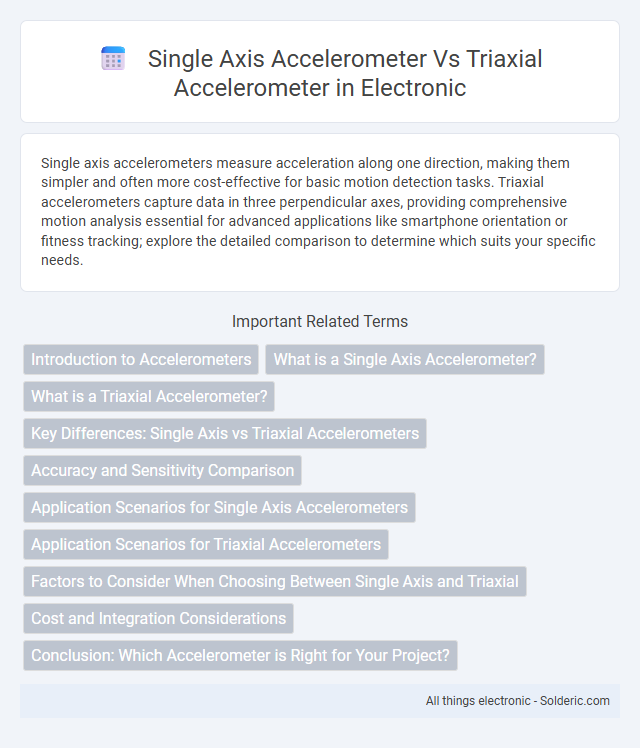Single axis accelerometers measure acceleration along one direction, making them simpler and often more cost-effective for basic motion detection tasks. Triaxial accelerometers capture data in three perpendicular axes, providing comprehensive motion analysis essential for advanced applications like smartphone orientation or fitness tracking; explore the detailed comparison to determine which suits your specific needs.
Comparison Table
| Feature | Single Axis Accelerometer | Triaxial Accelerometer |
|---|---|---|
| Measurement Axes | 1 axis (X or Y or Z) | 3 axes (X, Y, Z) |
| Data Output | Acceleration on one axis | Acceleration on three axes simultaneously |
| Applications | Simple tilt sensing, vibration monitoring | Motion tracking, orientation detection, 3D acceleration |
| Complexity | Lower complexity | Higher complexity |
| Cost | Generally lower cost | Generally higher cost |
| Power Consumption | Lower power consumption | Higher power consumption |
| Accuracy & Sensitivity | Limited to one axis accuracy | Improved accuracy with vector calculation |
Introduction to Accelerometers
Single axis accelerometers measure acceleration along a single plane, providing data suitable for applications requiring basic motion detection or tilt sensing. Triaxial accelerometers capture acceleration in three perpendicular axes (X, Y, and Z), enabling comprehensive three-dimensional motion analysis critical for advanced applications like mobile devices, automotive systems, and wearable technology. The multiaxial capability of triaxial accelerometers enhances precision and versatility compared to single axis variants, supporting complex movement detection and orientation tracking.
What is a Single Axis Accelerometer?
A Single Axis Accelerometer measures acceleration along one specific axis, providing precise data for motion detection or vibration analysis in that single direction. It is commonly used in applications where monitoring movement in one plane, such as tilt sensing or basic vibration monitoring, is sufficient. This device is simpler, less expensive, and consumes less power compared to triaxial accelerometers, making it ideal for specific, focused measurements.
What is a Triaxial Accelerometer?
A triaxial accelerometer measures acceleration along three perpendicular axes (X, Y, and Z), providing comprehensive motion detection and orientation data. Unlike a single axis accelerometer that detects movement in only one direction, triaxial sensors enable precise 3D motion analysis, crucial in applications such as smartphones, automotive systems, and wearable devices. The integration of three independent sensing elements enhances accuracy and versatility in monitoring dynamic acceleration and vibration.
Key Differences: Single Axis vs Triaxial Accelerometers
Single axis accelerometers measure acceleration along one direction, providing precise data for applications requiring linear motion detection, while triaxial accelerometers capture acceleration across three orthogonal axes (X, Y, and Z), enabling comprehensive analysis of multi-directional movement. The key difference lies in data dimensionality--single axis sensors offer simplicity and lower cost, whereas triaxial sensors deliver richer motion insight and greater versatility for complex motion tracking. Your choice depends on whether your application demands detailed spatial orientation or straightforward linear acceleration measurement.
Accuracy and Sensitivity Comparison
A triaxial accelerometer offers higher accuracy and sensitivity by measuring acceleration along three orthogonal axes, capturing motion in 3D space with greater precision compared to a single axis accelerometer. Single axis accelerometers are limited to detecting acceleration in only one direction, which can result in less accurate data for complex movements or multi-directional forces. The multi-axis data from triaxial sensors enables improved signal resolution and better noise reduction, enhancing the overall sensitivity and reliability of motion detection.
Application Scenarios for Single Axis Accelerometers
Single axis accelerometers are ideal for applications requiring measurement of acceleration along a single direction, such as vibration monitoring in machinery or tilt sensing in handheld devices. These sensors offer simplicity and cost-effectiveness for scenarios where multi-directional data is unnecessary, providing precise readings in constrained environments like automotive crash detection or basic motion tracking. Your choice of a single axis accelerometer is optimal when the focus is on specific directional measurement, minimizing complexity and power consumption.
Application Scenarios for Triaxial Accelerometers
Triaxial accelerometers are widely used in applications requiring precise motion detection across three-dimensional space, such as smartphone orientation, vehicle stability control, and wearable fitness tracking devices. Their ability to measure acceleration along the x, y, and z axes simultaneously provides comprehensive data critical for advanced robotics, aerospace navigation, and seismic monitoring. If your project demands accurate spatial motion analysis, triaxial accelerometers offer superior performance compared to single axis variants.
Factors to Consider When Choosing Between Single Axis and Triaxial
Choosing between single axis and triaxial accelerometers depends on the complexity of motion tracking and accuracy requirements. Single axis accelerometers are suitable for applications with movement primarily along one direction, offering lower cost and simpler integration. Triaxial accelerometers measure acceleration on three mutually perpendicular axes, providing comprehensive data for multidimensional motion analysis and enhanced sensitivity in dynamic environments.
Cost and Integration Considerations
Single axis accelerometers are generally more cost-effective due to their simpler design and fewer components, making them ideal for budget-sensitive projects. Triaxial accelerometers, while more expensive, offer comprehensive motion sensing by measuring acceleration across three axes, reducing the need for multiple sensors and simplifying system integration. Your choice depends on balancing cost constraints with the complexity of motion data required for your application.
Conclusion: Which Accelerometer is Right for Your Project?
Single axis accelerometers provide precise measurements along one direction, making them ideal for simple applications like tilt sensing or vibration monitoring with limited spatial requirements. Triaxial accelerometers capture motion across three dimensions, offering comprehensive data for complex activities such as motion tracking, wearable devices, and robotics, where multidirectional acceleration is critical. Choosing the right accelerometer depends on the project's complexity, spatial dynamics, and accuracy needs, with single axis sensors suiting straightforward tasks and triaxial models favored for detailed, multidimensional motion analysis.
single axis accelerometer vs triaxial accelerometer Infographic

 solderic.com
solderic.com